Welcome to  , 08 Mar 2014
, 08 Mar 2014
Fortnightly Report on Christianity in Former Soviet Bloc Countries,
by Dr. Robert D. Hosken
Click Here for previous issues, or to subscribe to Hosken-News.
(Privacy Policy: We will never sell, rent or give your email address to anyone else. Period.)
Special Issue on Ukraine
Because of the ongoing crisis in Ukraine, I felt it advisable to send this special issue highlighting the religious, historical and geopolitical background of that area of the world. It's an area that I've studied for over 50 years, and worked and lived there for nearly half that time. My wife and I have been in Ukraine, all of the former soviet-bloc states of Central Europe except Albania, we've stayed in Estonia and Latvia in the Baltics, and travelled from Krasnodar in the south of Russia, to St. Petersburg in the north, to Moscow in the middle where we lived for about eleven years, to Novosibirsk in Siberia, and we lived in the Russian Republics of Udmurtia, Mari-El and Tatarstan for over six years.
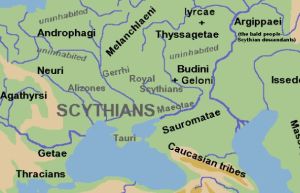 Let's begin with the ancient historical background. In Bible times Scythians inhabited most of the Crimean peninsula and territory to the north of it. Greeks also settled along the coast of Crimea and intermarried with the Scythians, bringing to them Greek culture and language. Ruins of the ancient Greek city of Chersonesus are located at the outskirts of modern Sevastopol, Crimea. Early Christian evangelists preached the Gospel in this area: Scythians are mentioned in Colossians 3:11, and some were possibly present in Jerusalem on the day of Pentecost - see Acts 2:9-10. The modern city of Simferopol has ruins of the ancient city of Scythian Neapolis. Some Russians and others assert that the Scythians were the precursors of the ancient Slavs, others say they intermarried and somewhat merged with the Slavs who in ancient times lived to the north of Scythian territory. (By clicking on the thumbnail photos here, you will be able to see them full-size and more easily read the print on these maps.)
Let's begin with the ancient historical background. In Bible times Scythians inhabited most of the Crimean peninsula and territory to the north of it. Greeks also settled along the coast of Crimea and intermarried with the Scythians, bringing to them Greek culture and language. Ruins of the ancient Greek city of Chersonesus are located at the outskirts of modern Sevastopol, Crimea. Early Christian evangelists preached the Gospel in this area: Scythians are mentioned in Colossians 3:11, and some were possibly present in Jerusalem on the day of Pentecost - see Acts 2:9-10. The modern city of Simferopol has ruins of the ancient city of Scythian Neapolis. Some Russians and others assert that the Scythians were the precursors of the ancient Slavs, others say they intermarried and somewhat merged with the Slavs who in ancient times lived to the north of Scythian territory. (By clicking on the thumbnail photos here, you will be able to see them full-size and more easily read the print on these maps.)
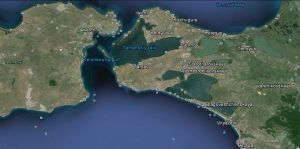 On the Crimean side of the Gulf of Kerch is the city by that name, and is just a 15-minute ferry ride from the strip of land jutting out from the Russian town of Ilyich. There is a road and rail line running down that strip of land, and another rail line from Kerch to other parts of Crimea and into Ukraine. This is the route by which most of the Russian-speaking "unlabeled Ukrainian self-defense forces" arrived in Crimea on vehicles with Russian licenses. Russia has announced that it plans to build a bridge over this shallow, narrow strait between Russia and Crimea. On the southern coast of the Russian side lies the city of "Blagoveschenskaya", meaning "Annunciation" in Russian - quite a contrast to the town of "Ilyich" named after Vladimir Ilyich Lenin! Further south along the Russian coast is the city of Anapa, a favorite vacation spot for many of our Russian friends.
On the Crimean side of the Gulf of Kerch is the city by that name, and is just a 15-minute ferry ride from the strip of land jutting out from the Russian town of Ilyich. There is a road and rail line running down that strip of land, and another rail line from Kerch to other parts of Crimea and into Ukraine. This is the route by which most of the Russian-speaking "unlabeled Ukrainian self-defense forces" arrived in Crimea on vehicles with Russian licenses. Russia has announced that it plans to build a bridge over this shallow, narrow strait between Russia and Crimea. On the southern coast of the Russian side lies the city of "Blagoveschenskaya", meaning "Annunciation" in Russian - quite a contrast to the town of "Ilyich" named after Vladimir Ilyich Lenin! Further south along the Russian coast is the city of Anapa, a favorite vacation spot for many of our Russian friends.
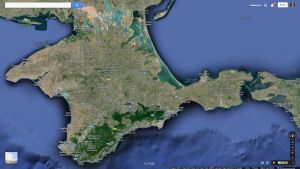 On this map of Crimea you can see Simferopol in the middle of the southern protrusion of Crimea. If you look closely, you'll also notice the port city of Novoozerne on the south side of the eastern protrusion of Crimea. This is where Russian barges towed an old, rusted-out, mothballed cruiser and sank it in the channel of the 400-meter-wide opening from Donuzlav Lake into the Black Sea, blocking access for several Ukrainian naval ships in that port to the Black Sea. By blockading this port and several other Ukrainian military bases in Crimea, Russia has effectively immobilized the Ukrainian military forces there. Keep in mind that in 1954 Krushchiov ceded Crimea to the Ukrainian SSR, but today 58% of the people in Crimea are still ethnic Russians, and Russia has long felt that Crimea is or ought to be forever a part of Russia. But the minority Ukrainians and Crimean Tatars feel threatened by a Russian takover of Crimea.
On this map of Crimea you can see Simferopol in the middle of the southern protrusion of Crimea. If you look closely, you'll also notice the port city of Novoozerne on the south side of the eastern protrusion of Crimea. This is where Russian barges towed an old, rusted-out, mothballed cruiser and sank it in the channel of the 400-meter-wide opening from Donuzlav Lake into the Black Sea, blocking access for several Ukrainian naval ships in that port to the Black Sea. By blockading this port and several other Ukrainian military bases in Crimea, Russia has effectively immobilized the Ukrainian military forces there. Keep in mind that in 1954 Krushchiov ceded Crimea to the Ukrainian SSR, but today 58% of the people in Crimea are still ethnic Russians, and Russia has long felt that Crimea is or ought to be forever a part of Russia. But the minority Ukrainians and Crimean Tatars feel threatened by a Russian takover of Crimea.
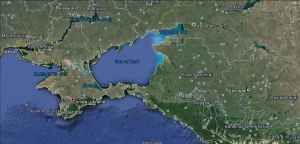 Here you can see Sochi on the southeast coast of the Black Sea and Donetsk in the northeast. Odesa, Mikolaiv and Kherson, shown here on the west of the map, are poplulated by many ethnic Russians and have recently expressed interest in joining Crimea: such a move would deprive Ukraine of its main ports on the Black Sea. Another city, Sevastopol, located on the south tip of Crimea, is home to the Russian navy's Black Sea fleet, and is key to understanding why Russia feels the need to keep Crimea under its control: Sevastopol is Russia's main warm-water port, which allows Russian naval and civilian ships to enter the Mediterranian Sea and beyond. Russia's other ports on the Baltic Sea, Arctic Ocean and Pacific Ocean are frozen over several months of the year. Russia conquered the Crimean peninsula in a war against the declining Turkish Ottoman Empire in 1792 in order to gain access to the Mediterranian via the Black Sea. Russia also fought a series of wars against the Turks from Moldova to the Balkans, trying to wrest control of these lands from the Muslims. But Russia's biggest war in this area was the Crimean War of 1853-1856 in which Russia claimed it was trying to protect the Christian minority in Syria. Russia lost that war. It can't afford to lose Crimea again.
Here you can see Sochi on the southeast coast of the Black Sea and Donetsk in the northeast. Odesa, Mikolaiv and Kherson, shown here on the west of the map, are poplulated by many ethnic Russians and have recently expressed interest in joining Crimea: such a move would deprive Ukraine of its main ports on the Black Sea. Another city, Sevastopol, located on the south tip of Crimea, is home to the Russian navy's Black Sea fleet, and is key to understanding why Russia feels the need to keep Crimea under its control: Sevastopol is Russia's main warm-water port, which allows Russian naval and civilian ships to enter the Mediterranian Sea and beyond. Russia's other ports on the Baltic Sea, Arctic Ocean and Pacific Ocean are frozen over several months of the year. Russia conquered the Crimean peninsula in a war against the declining Turkish Ottoman Empire in 1792 in order to gain access to the Mediterranian via the Black Sea. Russia also fought a series of wars against the Turks from Moldova to the Balkans, trying to wrest control of these lands from the Muslims. But Russia's biggest war in this area was the Crimean War of 1853-1856 in which Russia claimed it was trying to protect the Christian minority in Syria. Russia lost that war. It can't afford to lose Crimea again.
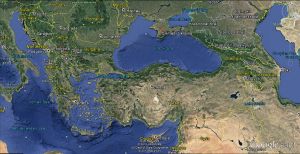 This map shows the "big picture" - all the way from the Balkans to the Caucasus. Hungary, Romania and Bulgaria as well as Poland, Lithuania, Latvia, Estonia, the Czech Republic and Slovakia have all joined the EU and NATO. Russia can't allow Moldova, Ukraine and Georgia to do so as well: in order to defend itself from invasion, Russia needs the strategic depth that these three countries plus Belarus provide. Russia has experienced too many invasions along the Great European Plain - from the Teutonic Knights, the Polish-Lithuanian Empire, the Austro-Hungarian Hapsburg Empire, the Napoleonic French Empire, the Prusso-German Empire, and the German Third Reich - to feel secure if Moldova, Ukraine and Georgia were to align with the EU and NATO.
This map shows the "big picture" - all the way from the Balkans to the Caucasus. Hungary, Romania and Bulgaria as well as Poland, Lithuania, Latvia, Estonia, the Czech Republic and Slovakia have all joined the EU and NATO. Russia can't allow Moldova, Ukraine and Georgia to do so as well: in order to defend itself from invasion, Russia needs the strategic depth that these three countries plus Belarus provide. Russia has experienced too many invasions along the Great European Plain - from the Teutonic Knights, the Polish-Lithuanian Empire, the Austro-Hungarian Hapsburg Empire, the Napoleonic French Empire, the Prusso-German Empire, and the German Third Reich - to feel secure if Moldova, Ukraine and Georgia were to align with the EU and NATO.
From an economic viewpoint, limiting access to the vast oil and gas reserves of Central Asia via Georgia is in Russia's best interests. From the religious perspective, Slavic Orthodoxy feels threatened by the encroachment of "sectarian" Protestantism and Roman Catholicism, as well as the secular humanism, from the West. And we should not forget Russia's interest in protecting the Eastern Christian minority in Syria and the Middle East, which was a major motivation behind the 1853-1856 Crimean War.
But the question arises: is not the imposing of Russian Orthodoxy on Ukraine a form of the ethno-phyletism heresy? For over twenty years now, Ukraine has been an independent country. According to Orthodox canon law, each independent country should be free to organize its own Orthodox Church. It may take many years for this to happen, but it shouldn't be hindered by outside forces. The ancient Slavs may have all been one cultural entity and all spoke old Slavonic a thousand years ago, but that undifferentiated ethno-lingustic Slavic group has now become the differentiated, distinct nations of Poland, the Czech Republic, Slovakia, Bulgaria, Serbia, Ukraine and Russia - each with its own language and culture. Some have their own Orthodox hierarchy and even their own Patriarchs. Why should not Ukraine have its own? Feel free to add your response in the "Comments" form below.
|
|
YOUR COMMENTS: |
 |
Tell us what you think! Click on "Sign the Guestbook" below, and your comments will appear immediately so others can respond.
(We reserve the right to retain only comments that are relevant and constructive in tone and content.)
|
|
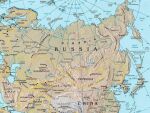 Please remember to pray for Christians in the former Soviet bloc countries, and for...
Please remember to pray for Christians in the former Soviet bloc countries, and for...
Your fellow-servants,
Bob & Cheryl
p.s. God promises a safe landing, not a calm passage.
This page may use IPower.com, so when you click on a link and buy something there, a small commission is credited to our affiliate account.
 , 08 Mar 2014
, 08 Mar 2014





